Business Culture and Organisational Challenges: Uniqlo's US Case Study
VerifiedAdded on 2020/03/04
|15
|4376
|1422
Report
AI Summary
This report delves into the cultural challenges faced by Uniqlo, a Japanese company, during its expansion into the United States. It begins with a background of Uniqlo and its business model, highlighting its international presence and operational strategies. The core of the report focuses on analyzing the cultural issues that hindered Uniqlo's success in the US market, particularly those related to cross-cultural differences and human resource management. The report employs Hofstede's Cultural Dimension Framework to evaluate these issues, comparing the cultural values of Japan and the US across dimensions such as uncertainty avoidance, individualism vs. collectivism, and long-term orientation. The analysis aims to provide insights into the cultural disparities that impacted Uniqlo's performance and offers recommendations for adapting business practices to align with the US cultural context. The report also contrasts Hofstede's framework with Schein's model of organizational culture, justifying the choice of the former for its comparative analysis capabilities.
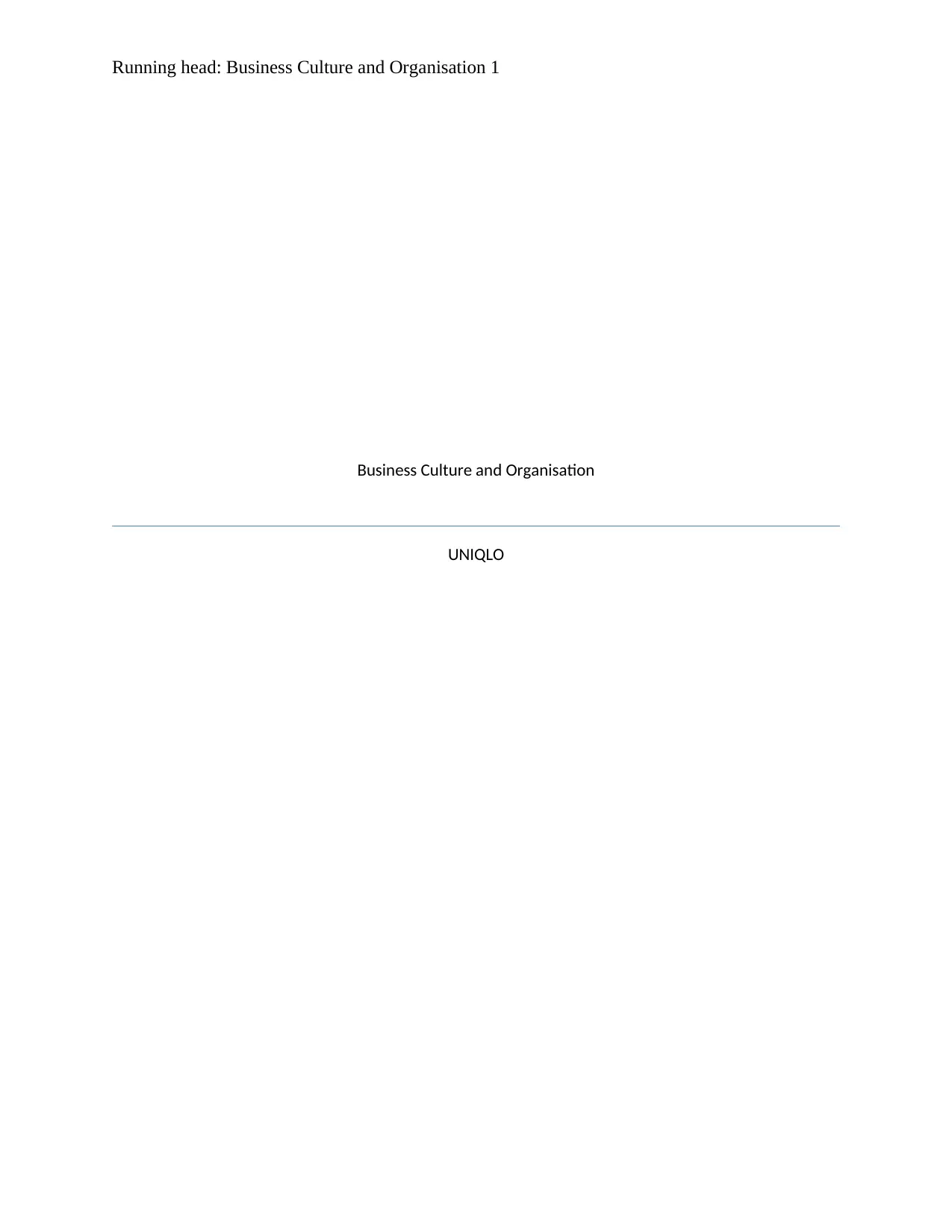
Running head: Business Culture and Organisation 1
Business Culture and Organisation
UNIQLO
Business Culture and Organisation
UNIQLO
Paraphrase This Document
Need a fresh take? Get an instant paraphrase of this document with our AI Paraphraser
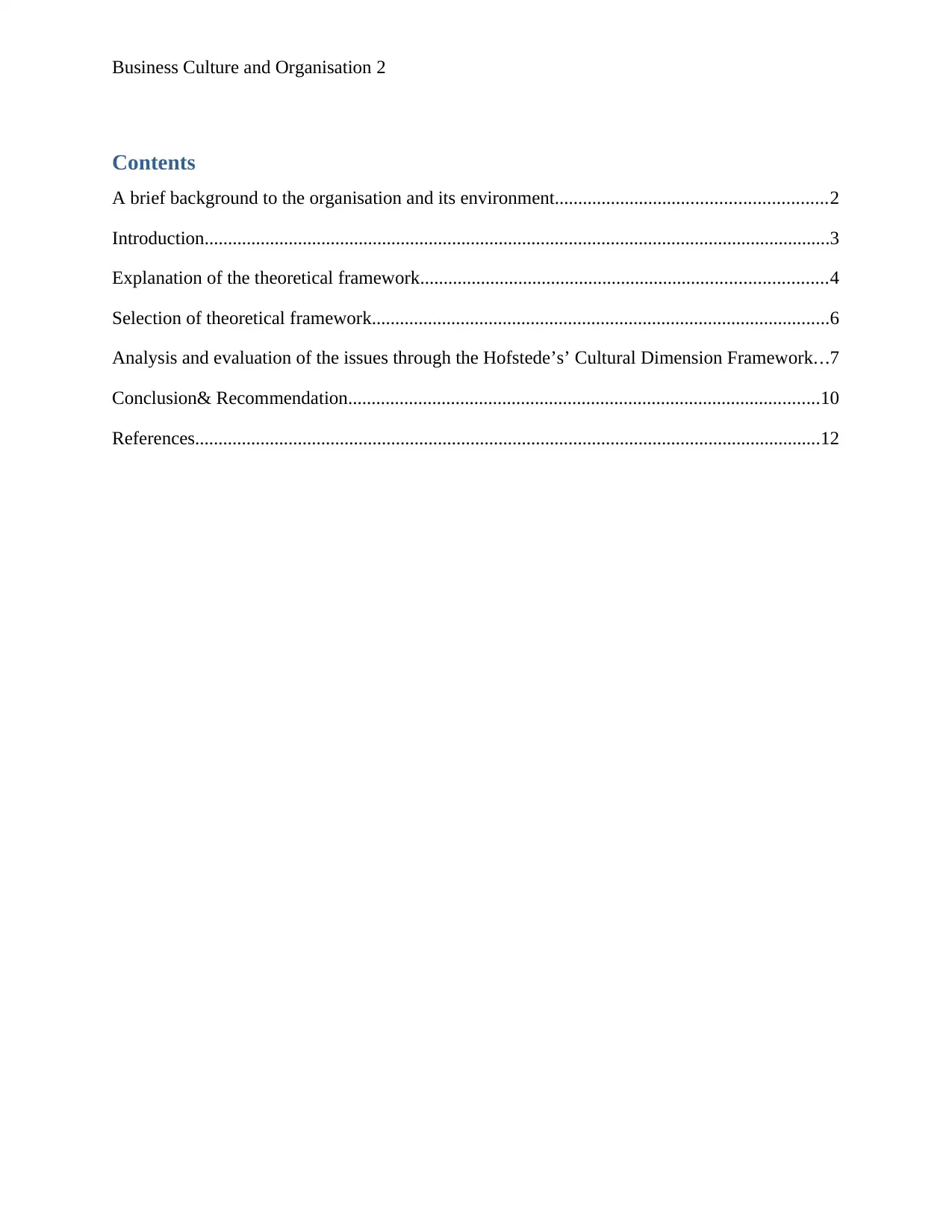
Business Culture and Organisation 2
Contents
A brief background to the organisation and its environment..........................................................2
Introduction......................................................................................................................................3
Explanation of the theoretical framework.......................................................................................4
Selection of theoretical framework..................................................................................................6
Analysis and evaluation of the issues through the Hofstede’s’ Cultural Dimension Framework...7
Conclusion& Recommendation.....................................................................................................10
References......................................................................................................................................12
Contents
A brief background to the organisation and its environment..........................................................2
Introduction......................................................................................................................................3
Explanation of the theoretical framework.......................................................................................4
Selection of theoretical framework..................................................................................................6
Analysis and evaluation of the issues through the Hofstede’s’ Cultural Dimension Framework...7
Conclusion& Recommendation.....................................................................................................10
References......................................................................................................................................12
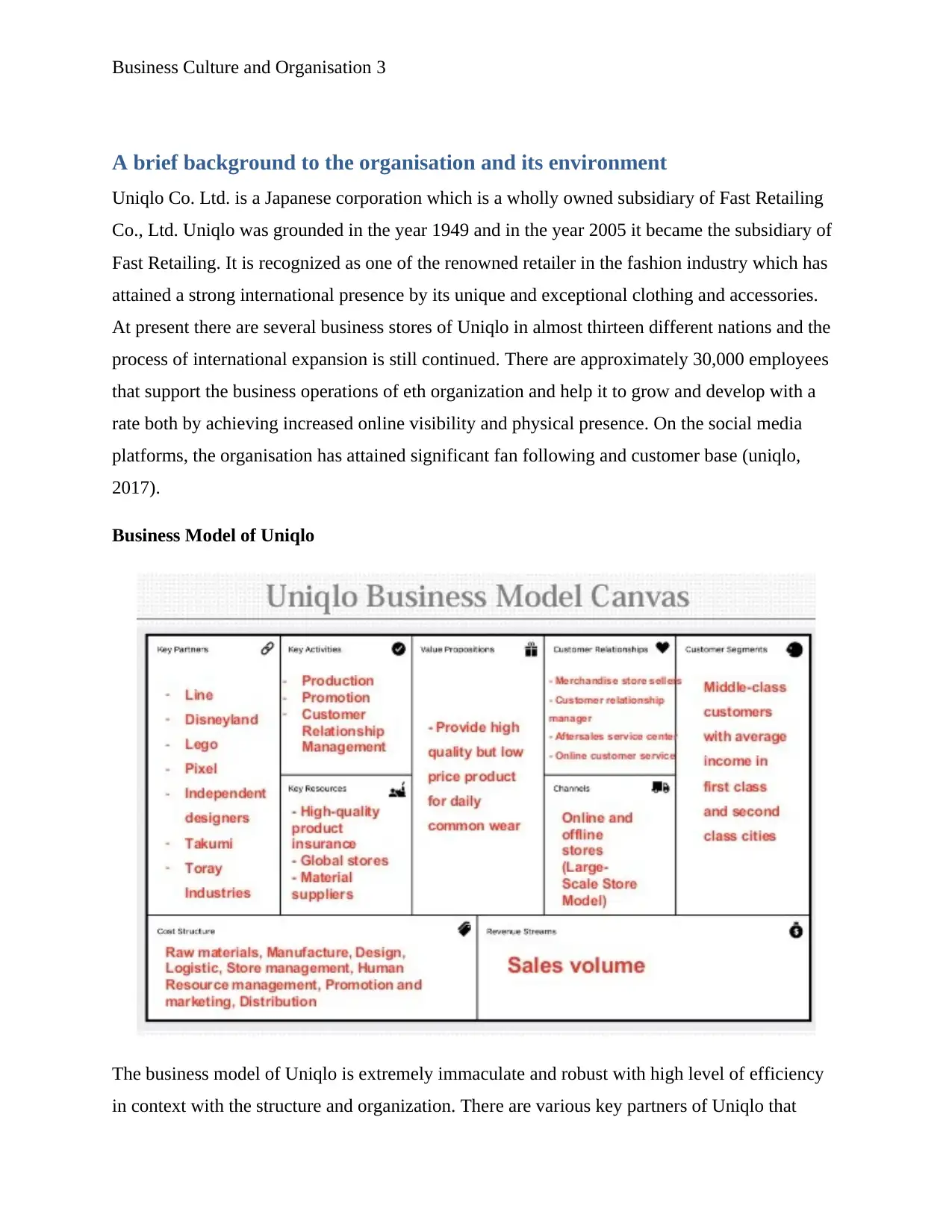
Business Culture and Organisation 3
A brief background to the organisation and its environment
Uniqlo Co. Ltd. is a Japanese corporation which is a wholly owned subsidiary of Fast Retailing
Co., Ltd. Uniqlo was grounded in the year 1949 and in the year 2005 it became the subsidiary of
Fast Retailing. It is recognized as one of the renowned retailer in the fashion industry which has
attained a strong international presence by its unique and exceptional clothing and accessories.
At present there are several business stores of Uniqlo in almost thirteen different nations and the
process of international expansion is still continued. There are approximately 30,000 employees
that support the business operations of eth organization and help it to grow and develop with a
rate both by achieving increased online visibility and physical presence. On the social media
platforms, the organisation has attained significant fan following and customer base (uniqlo,
2017).
Business Model of Uniqlo
The business model of Uniqlo is extremely immaculate and robust with high level of efficiency
in context with the structure and organization. There are various key partners of Uniqlo that
A brief background to the organisation and its environment
Uniqlo Co. Ltd. is a Japanese corporation which is a wholly owned subsidiary of Fast Retailing
Co., Ltd. Uniqlo was grounded in the year 1949 and in the year 2005 it became the subsidiary of
Fast Retailing. It is recognized as one of the renowned retailer in the fashion industry which has
attained a strong international presence by its unique and exceptional clothing and accessories.
At present there are several business stores of Uniqlo in almost thirteen different nations and the
process of international expansion is still continued. There are approximately 30,000 employees
that support the business operations of eth organization and help it to grow and develop with a
rate both by achieving increased online visibility and physical presence. On the social media
platforms, the organisation has attained significant fan following and customer base (uniqlo,
2017).
Business Model of Uniqlo
The business model of Uniqlo is extremely immaculate and robust with high level of efficiency
in context with the structure and organization. There are various key partners of Uniqlo that
⊘ This is a preview!⊘
Do you want full access?
Subscribe today to unlock all pages.

Trusted by 1+ million students worldwide
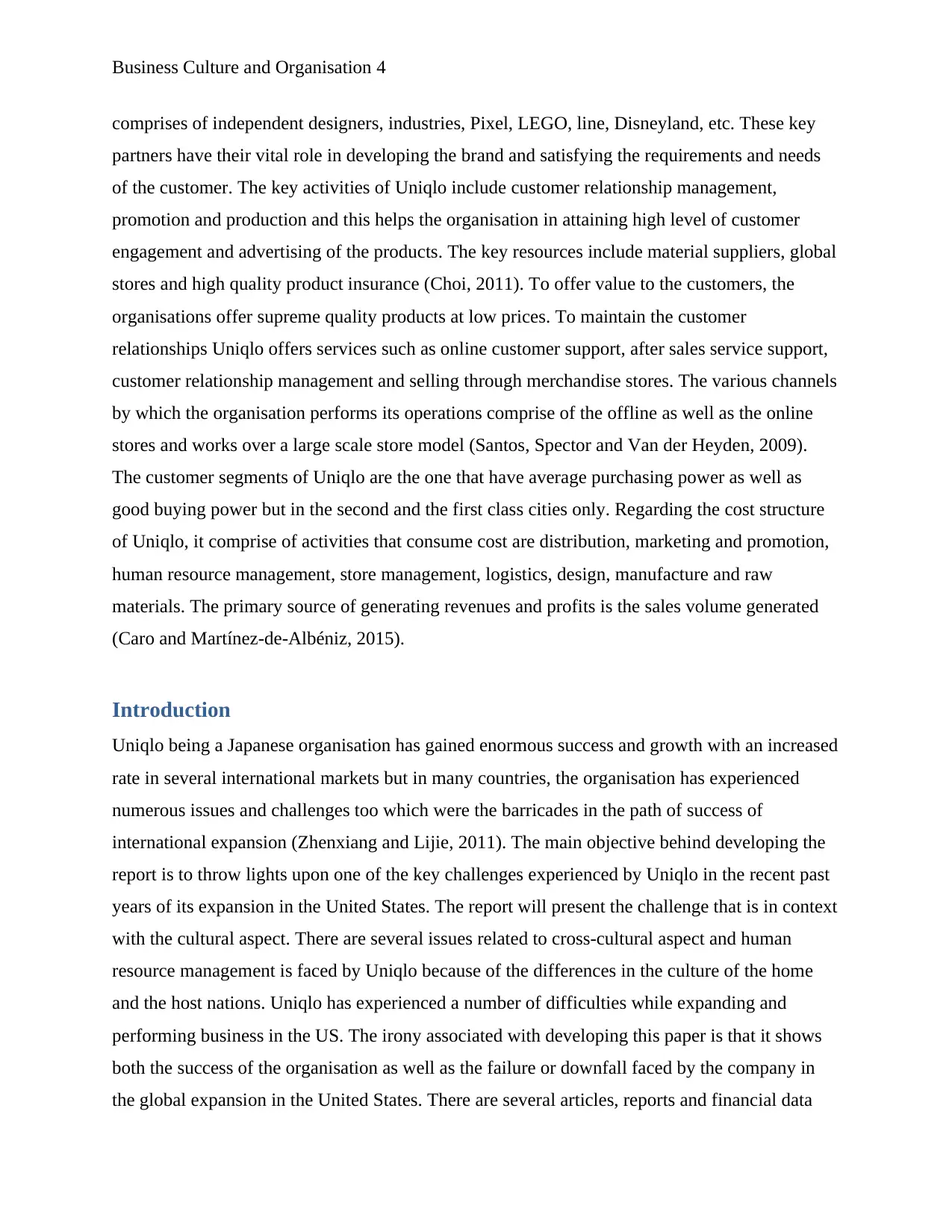
Business Culture and Organisation 4
comprises of independent designers, industries, Pixel, LEGO, line, Disneyland, etc. These key
partners have their vital role in developing the brand and satisfying the requirements and needs
of the customer. The key activities of Uniqlo include customer relationship management,
promotion and production and this helps the organisation in attaining high level of customer
engagement and advertising of the products. The key resources include material suppliers, global
stores and high quality product insurance (Choi, 2011). To offer value to the customers, the
organisations offer supreme quality products at low prices. To maintain the customer
relationships Uniqlo offers services such as online customer support, after sales service support,
customer relationship management and selling through merchandise stores. The various channels
by which the organisation performs its operations comprise of the offline as well as the online
stores and works over a large scale store model (Santos, Spector and Van der Heyden, 2009).
The customer segments of Uniqlo are the one that have average purchasing power as well as
good buying power but in the second and the first class cities only. Regarding the cost structure
of Uniqlo, it comprise of activities that consume cost are distribution, marketing and promotion,
human resource management, store management, logistics, design, manufacture and raw
materials. The primary source of generating revenues and profits is the sales volume generated
(Caro and Martínez-de-Albéniz, 2015).
Introduction
Uniqlo being a Japanese organisation has gained enormous success and growth with an increased
rate in several international markets but in many countries, the organisation has experienced
numerous issues and challenges too which were the barricades in the path of success of
international expansion (Zhenxiang and Lijie, 2011). The main objective behind developing the
report is to throw lights upon one of the key challenges experienced by Uniqlo in the recent past
years of its expansion in the United States. The report will present the challenge that is in context
with the cultural aspect. There are several issues related to cross-cultural aspect and human
resource management is faced by Uniqlo because of the differences in the culture of the home
and the host nations. Uniqlo has experienced a number of difficulties while expanding and
performing business in the US. The irony associated with developing this paper is that it shows
both the success of the organisation as well as the failure or downfall faced by the company in
the global expansion in the United States. There are several articles, reports and financial data
comprises of independent designers, industries, Pixel, LEGO, line, Disneyland, etc. These key
partners have their vital role in developing the brand and satisfying the requirements and needs
of the customer. The key activities of Uniqlo include customer relationship management,
promotion and production and this helps the organisation in attaining high level of customer
engagement and advertising of the products. The key resources include material suppliers, global
stores and high quality product insurance (Choi, 2011). To offer value to the customers, the
organisations offer supreme quality products at low prices. To maintain the customer
relationships Uniqlo offers services such as online customer support, after sales service support,
customer relationship management and selling through merchandise stores. The various channels
by which the organisation performs its operations comprise of the offline as well as the online
stores and works over a large scale store model (Santos, Spector and Van der Heyden, 2009).
The customer segments of Uniqlo are the one that have average purchasing power as well as
good buying power but in the second and the first class cities only. Regarding the cost structure
of Uniqlo, it comprise of activities that consume cost are distribution, marketing and promotion,
human resource management, store management, logistics, design, manufacture and raw
materials. The primary source of generating revenues and profits is the sales volume generated
(Caro and Martínez-de-Albéniz, 2015).
Introduction
Uniqlo being a Japanese organisation has gained enormous success and growth with an increased
rate in several international markets but in many countries, the organisation has experienced
numerous issues and challenges too which were the barricades in the path of success of
international expansion (Zhenxiang and Lijie, 2011). The main objective behind developing the
report is to throw lights upon one of the key challenges experienced by Uniqlo in the recent past
years of its expansion in the United States. The report will present the challenge that is in context
with the cultural aspect. There are several issues related to cross-cultural aspect and human
resource management is faced by Uniqlo because of the differences in the culture of the home
and the host nations. Uniqlo has experienced a number of difficulties while expanding and
performing business in the US. The irony associated with developing this paper is that it shows
both the success of the organisation as well as the failure or downfall faced by the company in
the global expansion in the United States. There are several articles, reports and financial data
Paraphrase This Document
Need a fresh take? Get an instant paraphrase of this document with our AI Paraphraser
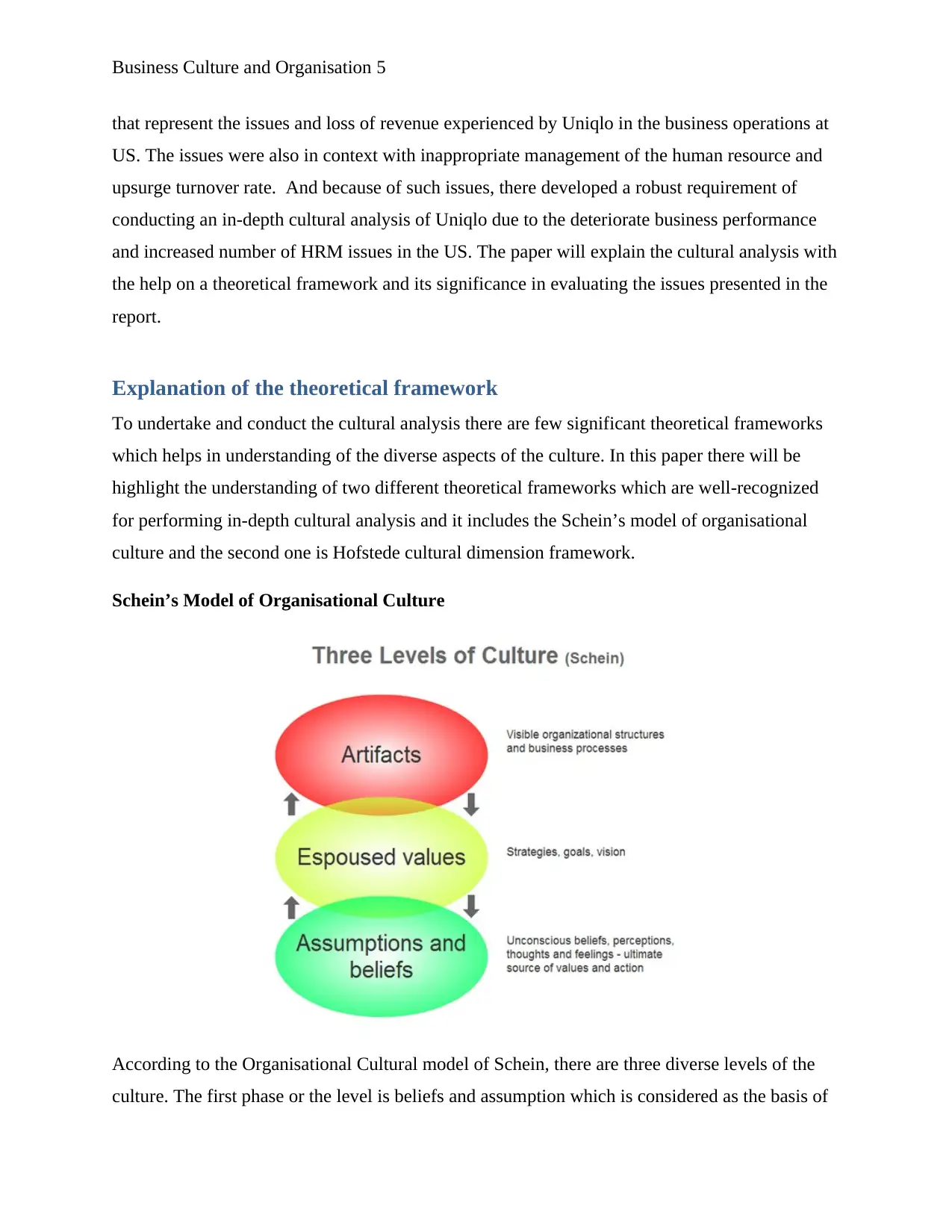
Business Culture and Organisation 5
that represent the issues and loss of revenue experienced by Uniqlo in the business operations at
US. The issues were also in context with inappropriate management of the human resource and
upsurge turnover rate. And because of such issues, there developed a robust requirement of
conducting an in-depth cultural analysis of Uniqlo due to the deteriorate business performance
and increased number of HRM issues in the US. The paper will explain the cultural analysis with
the help on a theoretical framework and its significance in evaluating the issues presented in the
report.
Explanation of the theoretical framework
To undertake and conduct the cultural analysis there are few significant theoretical frameworks
which helps in understanding of the diverse aspects of the culture. In this paper there will be
highlight the understanding of two different theoretical frameworks which are well-recognized
for performing in-depth cultural analysis and it includes the Schein’s model of organisational
culture and the second one is Hofstede cultural dimension framework.
Schein’s Model of Organisational Culture
According to the Organisational Cultural model of Schein, there are three diverse levels of the
culture. The first phase or the level is beliefs and assumption which is considered as the basis of
that represent the issues and loss of revenue experienced by Uniqlo in the business operations at
US. The issues were also in context with inappropriate management of the human resource and
upsurge turnover rate. And because of such issues, there developed a robust requirement of
conducting an in-depth cultural analysis of Uniqlo due to the deteriorate business performance
and increased number of HRM issues in the US. The paper will explain the cultural analysis with
the help on a theoretical framework and its significance in evaluating the issues presented in the
report.
Explanation of the theoretical framework
To undertake and conduct the cultural analysis there are few significant theoretical frameworks
which helps in understanding of the diverse aspects of the culture. In this paper there will be
highlight the understanding of two different theoretical frameworks which are well-recognized
for performing in-depth cultural analysis and it includes the Schein’s model of organisational
culture and the second one is Hofstede cultural dimension framework.
Schein’s Model of Organisational Culture
According to the Organisational Cultural model of Schein, there are three diverse levels of the
culture. The first phase or the level is beliefs and assumption which is considered as the basis of
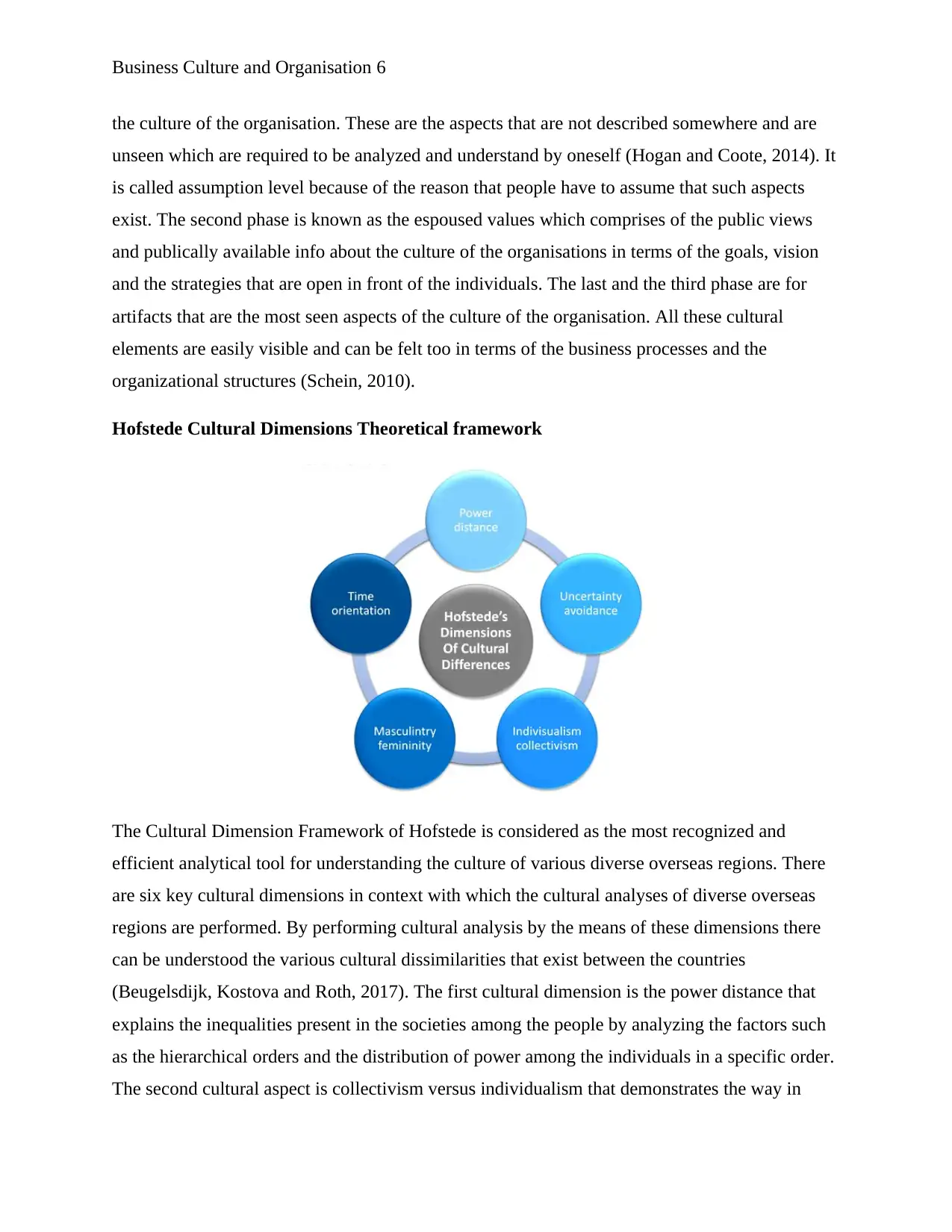
Business Culture and Organisation 6
the culture of the organisation. These are the aspects that are not described somewhere and are
unseen which are required to be analyzed and understand by oneself (Hogan and Coote, 2014). It
is called assumption level because of the reason that people have to assume that such aspects
exist. The second phase is known as the espoused values which comprises of the public views
and publically available info about the culture of the organisations in terms of the goals, vision
and the strategies that are open in front of the individuals. The last and the third phase are for
artifacts that are the most seen aspects of the culture of the organisation. All these cultural
elements are easily visible and can be felt too in terms of the business processes and the
organizational structures (Schein, 2010).
Hofstede Cultural Dimensions Theoretical framework
The Cultural Dimension Framework of Hofstede is considered as the most recognized and
efficient analytical tool for understanding the culture of various diverse overseas regions. There
are six key cultural dimensions in context with which the cultural analyses of diverse overseas
regions are performed. By performing cultural analysis by the means of these dimensions there
can be understood the various cultural dissimilarities that exist between the countries
(Beugelsdijk, Kostova and Roth, 2017). The first cultural dimension is the power distance that
explains the inequalities present in the societies among the people by analyzing the factors such
as the hierarchical orders and the distribution of power among the individuals in a specific order.
The second cultural aspect is collectivism versus individualism that demonstrates the way in
the culture of the organisation. These are the aspects that are not described somewhere and are
unseen which are required to be analyzed and understand by oneself (Hogan and Coote, 2014). It
is called assumption level because of the reason that people have to assume that such aspects
exist. The second phase is known as the espoused values which comprises of the public views
and publically available info about the culture of the organisations in terms of the goals, vision
and the strategies that are open in front of the individuals. The last and the third phase are for
artifacts that are the most seen aspects of the culture of the organisation. All these cultural
elements are easily visible and can be felt too in terms of the business processes and the
organizational structures (Schein, 2010).
Hofstede Cultural Dimensions Theoretical framework
The Cultural Dimension Framework of Hofstede is considered as the most recognized and
efficient analytical tool for understanding the culture of various diverse overseas regions. There
are six key cultural dimensions in context with which the cultural analyses of diverse overseas
regions are performed. By performing cultural analysis by the means of these dimensions there
can be understood the various cultural dissimilarities that exist between the countries
(Beugelsdijk, Kostova and Roth, 2017). The first cultural dimension is the power distance that
explains the inequalities present in the societies among the people by analyzing the factors such
as the hierarchical orders and the distribution of power among the individuals in a specific order.
The second cultural aspect is collectivism versus individualism that demonstrates the way in
⊘ This is a preview!⊘
Do you want full access?
Subscribe today to unlock all pages.

Trusted by 1+ million students worldwide
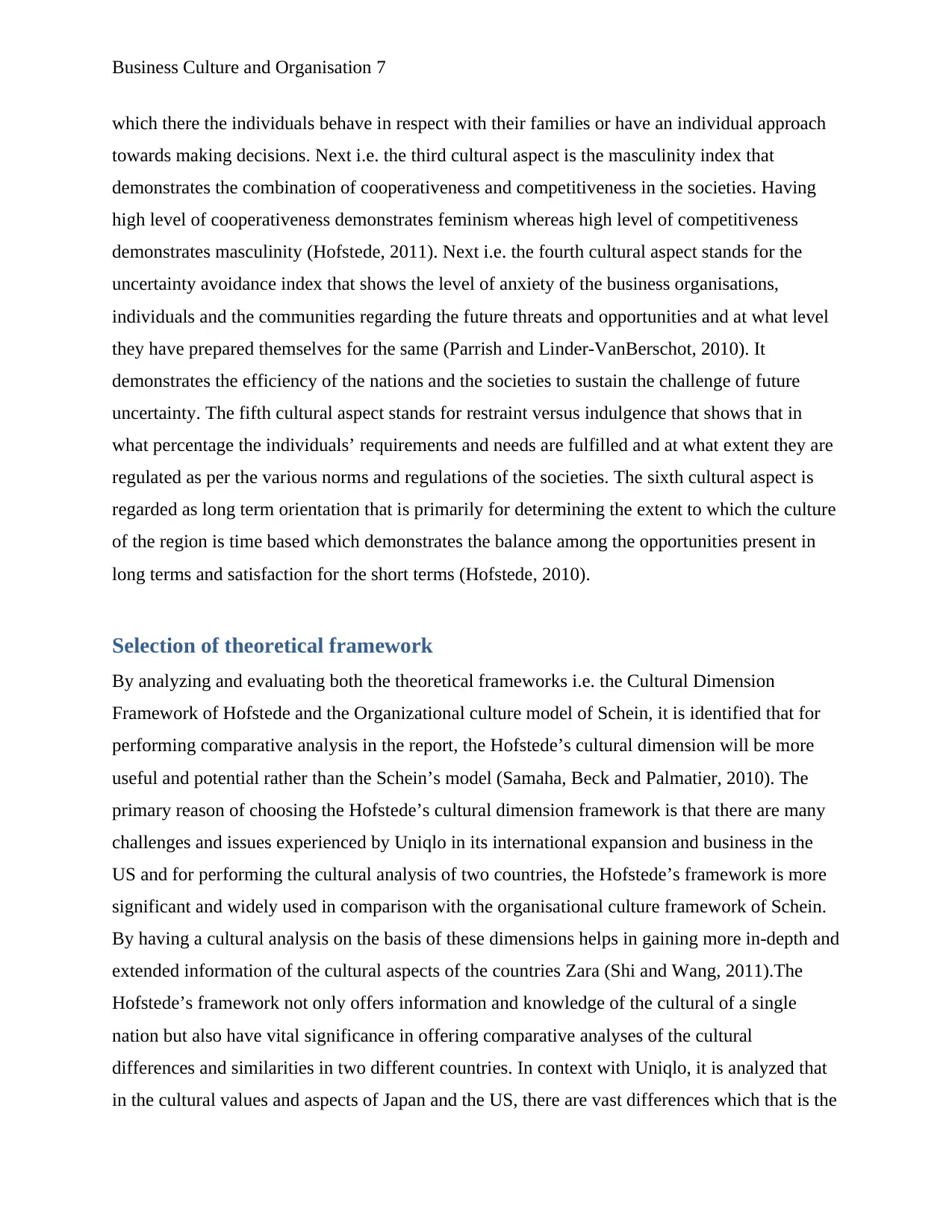
Business Culture and Organisation 7
which there the individuals behave in respect with their families or have an individual approach
towards making decisions. Next i.e. the third cultural aspect is the masculinity index that
demonstrates the combination of cooperativeness and competitiveness in the societies. Having
high level of cooperativeness demonstrates feminism whereas high level of competitiveness
demonstrates masculinity (Hofstede, 2011). Next i.e. the fourth cultural aspect stands for the
uncertainty avoidance index that shows the level of anxiety of the business organisations,
individuals and the communities regarding the future threats and opportunities and at what level
they have prepared themselves for the same (Parrish and Linder-VanBerschot, 2010). It
demonstrates the efficiency of the nations and the societies to sustain the challenge of future
uncertainty. The fifth cultural aspect stands for restraint versus indulgence that shows that in
what percentage the individuals’ requirements and needs are fulfilled and at what extent they are
regulated as per the various norms and regulations of the societies. The sixth cultural aspect is
regarded as long term orientation that is primarily for determining the extent to which the culture
of the region is time based which demonstrates the balance among the opportunities present in
long terms and satisfaction for the short terms (Hofstede, 2010).
Selection of theoretical framework
By analyzing and evaluating both the theoretical frameworks i.e. the Cultural Dimension
Framework of Hofstede and the Organizational culture model of Schein, it is identified that for
performing comparative analysis in the report, the Hofstede’s cultural dimension will be more
useful and potential rather than the Schein’s model (Samaha, Beck and Palmatier, 2010). The
primary reason of choosing the Hofstede’s cultural dimension framework is that there are many
challenges and issues experienced by Uniqlo in its international expansion and business in the
US and for performing the cultural analysis of two countries, the Hofstede’s framework is more
significant and widely used in comparison with the organisational culture framework of Schein.
By having a cultural analysis on the basis of these dimensions helps in gaining more in-depth and
extended information of the cultural aspects of the countries Zara (Shi and Wang, 2011).The
Hofstede’s framework not only offers information and knowledge of the cultural of a single
nation but also have vital significance in offering comparative analyses of the cultural
differences and similarities in two different countries. In context with Uniqlo, it is analyzed that
in the cultural values and aspects of Japan and the US, there are vast differences which that is the
which there the individuals behave in respect with their families or have an individual approach
towards making decisions. Next i.e. the third cultural aspect is the masculinity index that
demonstrates the combination of cooperativeness and competitiveness in the societies. Having
high level of cooperativeness demonstrates feminism whereas high level of competitiveness
demonstrates masculinity (Hofstede, 2011). Next i.e. the fourth cultural aspect stands for the
uncertainty avoidance index that shows the level of anxiety of the business organisations,
individuals and the communities regarding the future threats and opportunities and at what level
they have prepared themselves for the same (Parrish and Linder-VanBerschot, 2010). It
demonstrates the efficiency of the nations and the societies to sustain the challenge of future
uncertainty. The fifth cultural aspect stands for restraint versus indulgence that shows that in
what percentage the individuals’ requirements and needs are fulfilled and at what extent they are
regulated as per the various norms and regulations of the societies. The sixth cultural aspect is
regarded as long term orientation that is primarily for determining the extent to which the culture
of the region is time based which demonstrates the balance among the opportunities present in
long terms and satisfaction for the short terms (Hofstede, 2010).
Selection of theoretical framework
By analyzing and evaluating both the theoretical frameworks i.e. the Cultural Dimension
Framework of Hofstede and the Organizational culture model of Schein, it is identified that for
performing comparative analysis in the report, the Hofstede’s cultural dimension will be more
useful and potential rather than the Schein’s model (Samaha, Beck and Palmatier, 2010). The
primary reason of choosing the Hofstede’s cultural dimension framework is that there are many
challenges and issues experienced by Uniqlo in its international expansion and business in the
US and for performing the cultural analysis of two countries, the Hofstede’s framework is more
significant and widely used in comparison with the organisational culture framework of Schein.
By having a cultural analysis on the basis of these dimensions helps in gaining more in-depth and
extended information of the cultural aspects of the countries Zara (Shi and Wang, 2011).The
Hofstede’s framework not only offers information and knowledge of the cultural of a single
nation but also have vital significance in offering comparative analyses of the cultural
differences and similarities in two different countries. In context with Uniqlo, it is analyzed that
in the cultural values and aspects of Japan and the US, there are vast differences which that is the
Paraphrase This Document
Need a fresh take? Get an instant paraphrase of this document with our AI Paraphraser
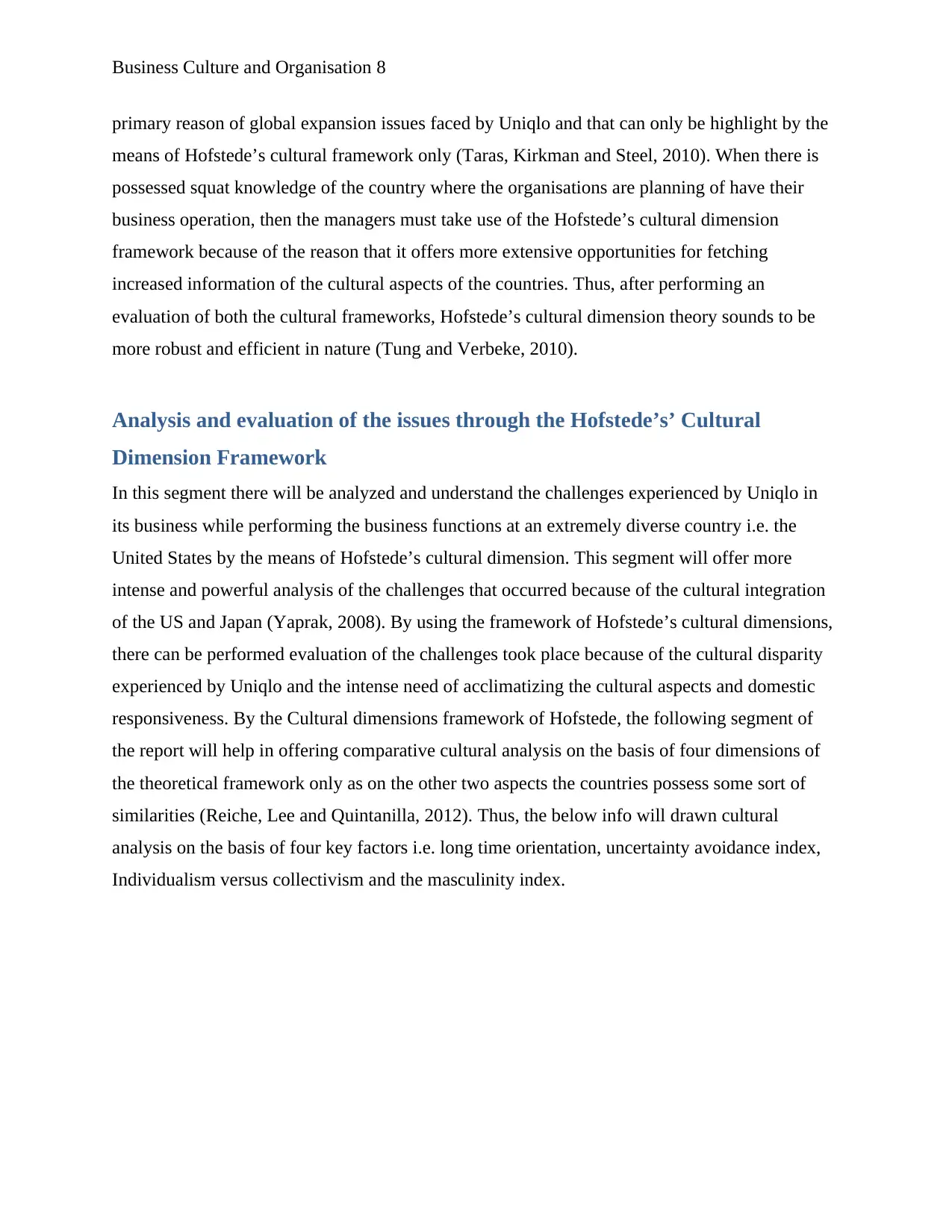
Business Culture and Organisation 8
primary reason of global expansion issues faced by Uniqlo and that can only be highlight by the
means of Hofstede’s cultural framework only (Taras, Kirkman and Steel, 2010). When there is
possessed squat knowledge of the country where the organisations are planning of have their
business operation, then the managers must take use of the Hofstede’s cultural dimension
framework because of the reason that it offers more extensive opportunities for fetching
increased information of the cultural aspects of the countries. Thus, after performing an
evaluation of both the cultural frameworks, Hofstede’s cultural dimension theory sounds to be
more robust and efficient in nature (Tung and Verbeke, 2010).
Analysis and evaluation of the issues through the Hofstede’s’ Cultural
Dimension Framework
In this segment there will be analyzed and understand the challenges experienced by Uniqlo in
its business while performing the business functions at an extremely diverse country i.e. the
United States by the means of Hofstede’s cultural dimension. This segment will offer more
intense and powerful analysis of the challenges that occurred because of the cultural integration
of the US and Japan (Yaprak, 2008). By using the framework of Hofstede’s cultural dimensions,
there can be performed evaluation of the challenges took place because of the cultural disparity
experienced by Uniqlo and the intense need of acclimatizing the cultural aspects and domestic
responsiveness. By the Cultural dimensions framework of Hofstede, the following segment of
the report will help in offering comparative cultural analysis on the basis of four dimensions of
the theoretical framework only as on the other two aspects the countries possess some sort of
similarities (Reiche, Lee and Quintanilla, 2012). Thus, the below info will drawn cultural
analysis on the basis of four key factors i.e. long time orientation, uncertainty avoidance index,
Individualism versus collectivism and the masculinity index.
primary reason of global expansion issues faced by Uniqlo and that can only be highlight by the
means of Hofstede’s cultural framework only (Taras, Kirkman and Steel, 2010). When there is
possessed squat knowledge of the country where the organisations are planning of have their
business operation, then the managers must take use of the Hofstede’s cultural dimension
framework because of the reason that it offers more extensive opportunities for fetching
increased information of the cultural aspects of the countries. Thus, after performing an
evaluation of both the cultural frameworks, Hofstede’s cultural dimension theory sounds to be
more robust and efficient in nature (Tung and Verbeke, 2010).
Analysis and evaluation of the issues through the Hofstede’s’ Cultural
Dimension Framework
In this segment there will be analyzed and understand the challenges experienced by Uniqlo in
its business while performing the business functions at an extremely diverse country i.e. the
United States by the means of Hofstede’s cultural dimension. This segment will offer more
intense and powerful analysis of the challenges that occurred because of the cultural integration
of the US and Japan (Yaprak, 2008). By using the framework of Hofstede’s cultural dimensions,
there can be performed evaluation of the challenges took place because of the cultural disparity
experienced by Uniqlo and the intense need of acclimatizing the cultural aspects and domestic
responsiveness. By the Cultural dimensions framework of Hofstede, the following segment of
the report will help in offering comparative cultural analysis on the basis of four dimensions of
the theoretical framework only as on the other two aspects the countries possess some sort of
similarities (Reiche, Lee and Quintanilla, 2012). Thus, the below info will drawn cultural
analysis on the basis of four key factors i.e. long time orientation, uncertainty avoidance index,
Individualism versus collectivism and the masculinity index.
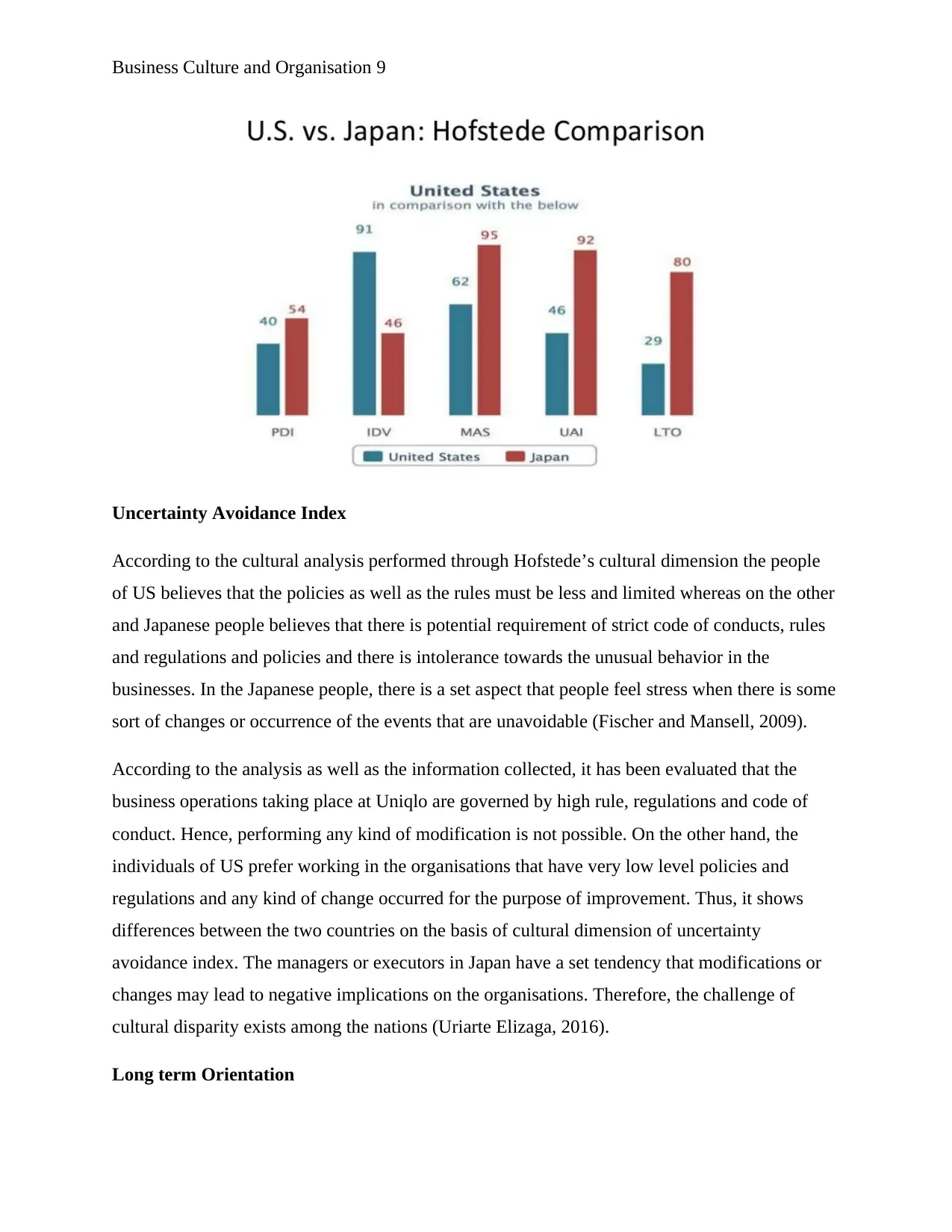
Business Culture and Organisation 9
Uncertainty Avoidance Index
According to the cultural analysis performed through Hofstede’s cultural dimension the people
of US believes that the policies as well as the rules must be less and limited whereas on the other
and Japanese people believes that there is potential requirement of strict code of conducts, rules
and regulations and policies and there is intolerance towards the unusual behavior in the
businesses. In the Japanese people, there is a set aspect that people feel stress when there is some
sort of changes or occurrence of the events that are unavoidable (Fischer and Mansell, 2009).
According to the analysis as well as the information collected, it has been evaluated that the
business operations taking place at Uniqlo are governed by high rule, regulations and code of
conduct. Hence, performing any kind of modification is not possible. On the other hand, the
individuals of US prefer working in the organisations that have very low level policies and
regulations and any kind of change occurred for the purpose of improvement. Thus, it shows
differences between the two countries on the basis of cultural dimension of uncertainty
avoidance index. The managers or executors in Japan have a set tendency that modifications or
changes may lead to negative implications on the organisations. Therefore, the challenge of
cultural disparity exists among the nations (Uriarte Elizaga, 2016).
Long term Orientation
Uncertainty Avoidance Index
According to the cultural analysis performed through Hofstede’s cultural dimension the people
of US believes that the policies as well as the rules must be less and limited whereas on the other
and Japanese people believes that there is potential requirement of strict code of conducts, rules
and regulations and policies and there is intolerance towards the unusual behavior in the
businesses. In the Japanese people, there is a set aspect that people feel stress when there is some
sort of changes or occurrence of the events that are unavoidable (Fischer and Mansell, 2009).
According to the analysis as well as the information collected, it has been evaluated that the
business operations taking place at Uniqlo are governed by high rule, regulations and code of
conduct. Hence, performing any kind of modification is not possible. On the other hand, the
individuals of US prefer working in the organisations that have very low level policies and
regulations and any kind of change occurred for the purpose of improvement. Thus, it shows
differences between the two countries on the basis of cultural dimension of uncertainty
avoidance index. The managers or executors in Japan have a set tendency that modifications or
changes may lead to negative implications on the organisations. Therefore, the challenge of
cultural disparity exists among the nations (Uriarte Elizaga, 2016).
Long term Orientation
⊘ This is a preview!⊘
Do you want full access?
Subscribe today to unlock all pages.

Trusted by 1+ million students worldwide
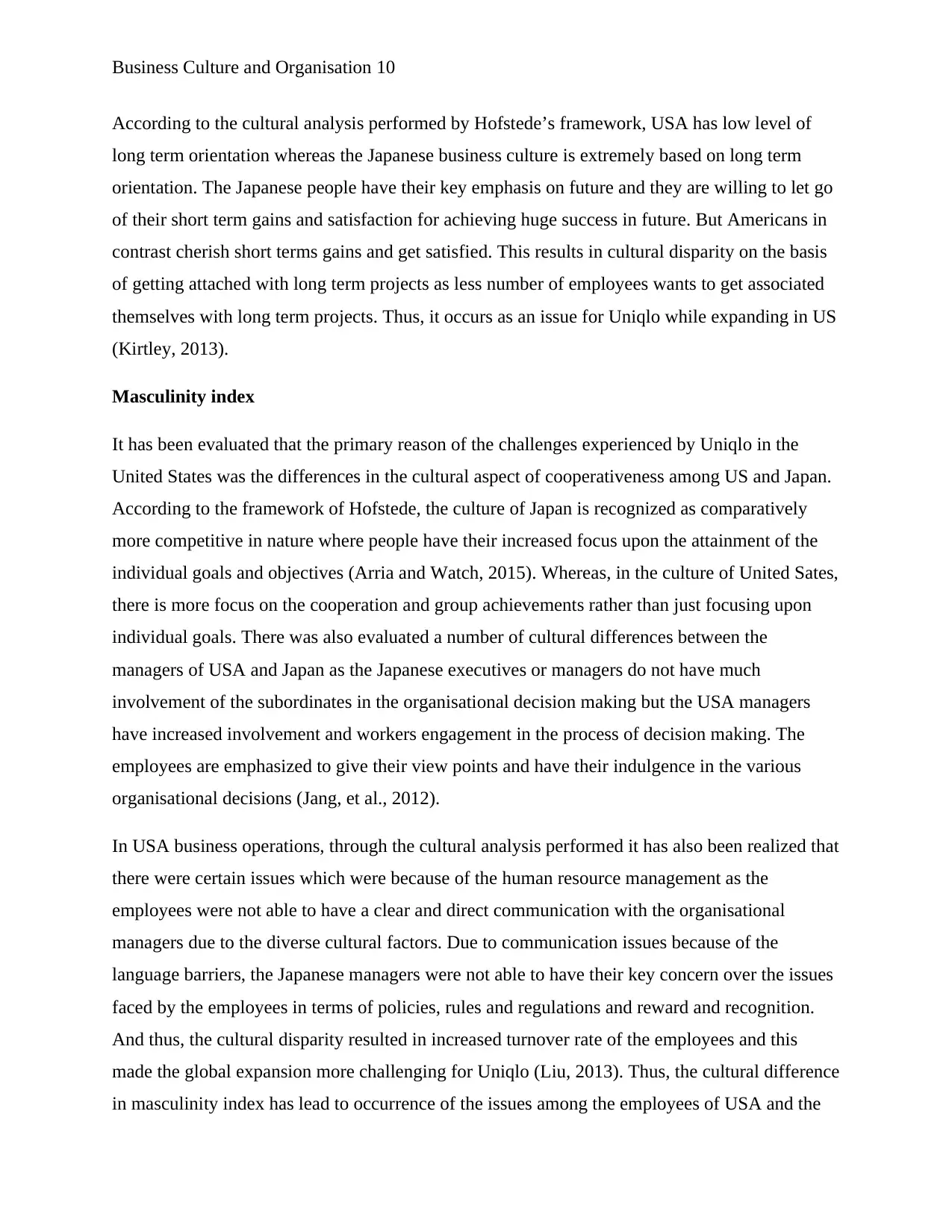
Business Culture and Organisation 10
According to the cultural analysis performed by Hofstede’s framework, USA has low level of
long term orientation whereas the Japanese business culture is extremely based on long term
orientation. The Japanese people have their key emphasis on future and they are willing to let go
of their short term gains and satisfaction for achieving huge success in future. But Americans in
contrast cherish short terms gains and get satisfied. This results in cultural disparity on the basis
of getting attached with long term projects as less number of employees wants to get associated
themselves with long term projects. Thus, it occurs as an issue for Uniqlo while expanding in US
(Kirtley, 2013).
Masculinity index
It has been evaluated that the primary reason of the challenges experienced by Uniqlo in the
United States was the differences in the cultural aspect of cooperativeness among US and Japan.
According to the framework of Hofstede, the culture of Japan is recognized as comparatively
more competitive in nature where people have their increased focus upon the attainment of the
individual goals and objectives (Arria and Watch, 2015). Whereas, in the culture of United Sates,
there is more focus on the cooperation and group achievements rather than just focusing upon
individual goals. There was also evaluated a number of cultural differences between the
managers of USA and Japan as the Japanese executives or managers do not have much
involvement of the subordinates in the organisational decision making but the USA managers
have increased involvement and workers engagement in the process of decision making. The
employees are emphasized to give their view points and have their indulgence in the various
organisational decisions (Jang, et al., 2012).
In USA business operations, through the cultural analysis performed it has also been realized that
there were certain issues which were because of the human resource management as the
employees were not able to have a clear and direct communication with the organisational
managers due to the diverse cultural factors. Due to communication issues because of the
language barriers, the Japanese managers were not able to have their key concern over the issues
faced by the employees in terms of policies, rules and regulations and reward and recognition.
And thus, the cultural disparity resulted in increased turnover rate of the employees and this
made the global expansion more challenging for Uniqlo (Liu, 2013). Thus, the cultural difference
in masculinity index has lead to occurrence of the issues among the employees of USA and the
According to the cultural analysis performed by Hofstede’s framework, USA has low level of
long term orientation whereas the Japanese business culture is extremely based on long term
orientation. The Japanese people have their key emphasis on future and they are willing to let go
of their short term gains and satisfaction for achieving huge success in future. But Americans in
contrast cherish short terms gains and get satisfied. This results in cultural disparity on the basis
of getting attached with long term projects as less number of employees wants to get associated
themselves with long term projects. Thus, it occurs as an issue for Uniqlo while expanding in US
(Kirtley, 2013).
Masculinity index
It has been evaluated that the primary reason of the challenges experienced by Uniqlo in the
United States was the differences in the cultural aspect of cooperativeness among US and Japan.
According to the framework of Hofstede, the culture of Japan is recognized as comparatively
more competitive in nature where people have their increased focus upon the attainment of the
individual goals and objectives (Arria and Watch, 2015). Whereas, in the culture of United Sates,
there is more focus on the cooperation and group achievements rather than just focusing upon
individual goals. There was also evaluated a number of cultural differences between the
managers of USA and Japan as the Japanese executives or managers do not have much
involvement of the subordinates in the organisational decision making but the USA managers
have increased involvement and workers engagement in the process of decision making. The
employees are emphasized to give their view points and have their indulgence in the various
organisational decisions (Jang, et al., 2012).
In USA business operations, through the cultural analysis performed it has also been realized that
there were certain issues which were because of the human resource management as the
employees were not able to have a clear and direct communication with the organisational
managers due to the diverse cultural factors. Due to communication issues because of the
language barriers, the Japanese managers were not able to have their key concern over the issues
faced by the employees in terms of policies, rules and regulations and reward and recognition.
And thus, the cultural disparity resulted in increased turnover rate of the employees and this
made the global expansion more challenging for Uniqlo (Liu, 2013). Thus, the cultural difference
in masculinity index has lead to occurrence of the issues among the employees of USA and the
Paraphrase This Document
Need a fresh take? Get an instant paraphrase of this document with our AI Paraphraser
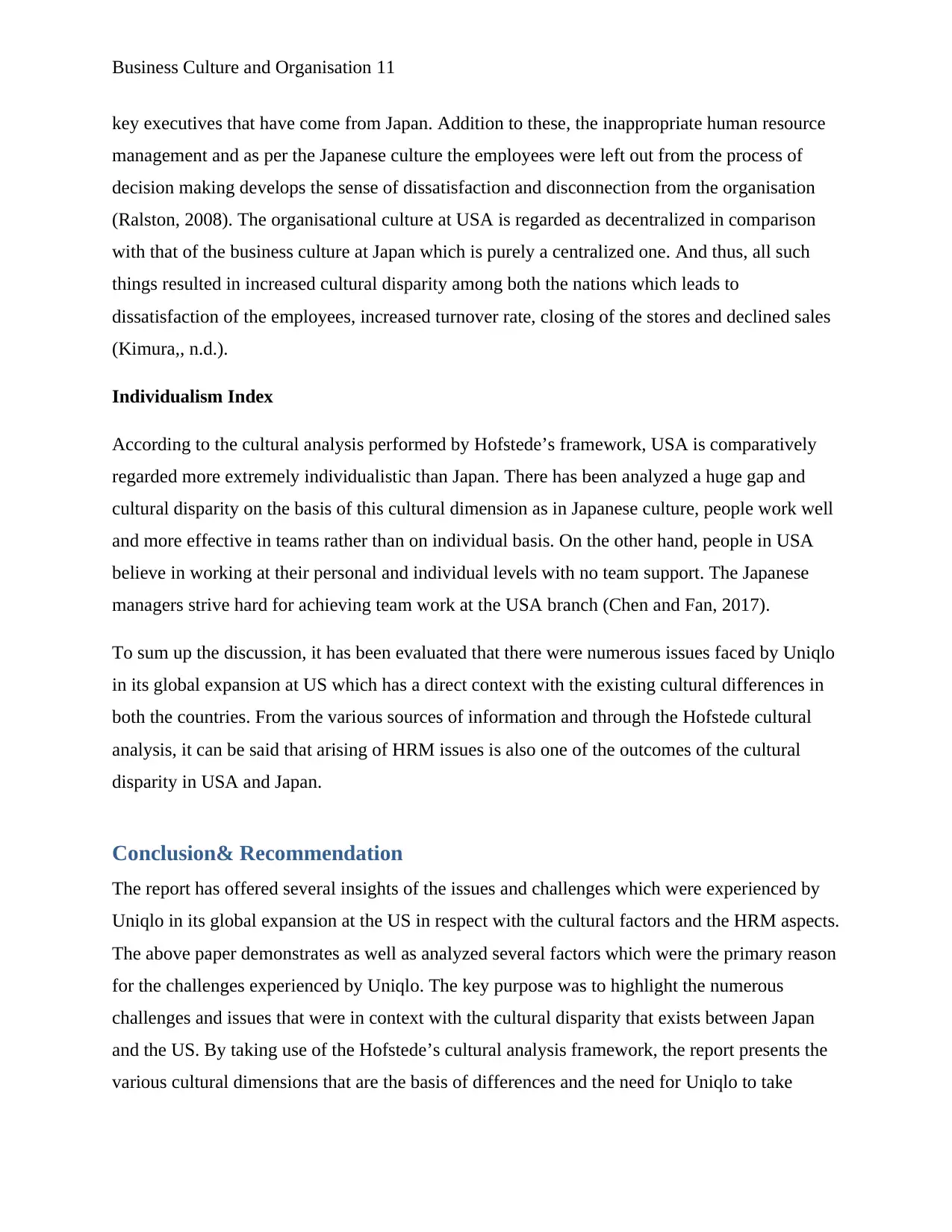
Business Culture and Organisation 11
key executives that have come from Japan. Addition to these, the inappropriate human resource
management and as per the Japanese culture the employees were left out from the process of
decision making develops the sense of dissatisfaction and disconnection from the organisation
(Ralston, 2008). The organisational culture at USA is regarded as decentralized in comparison
with that of the business culture at Japan which is purely a centralized one. And thus, all such
things resulted in increased cultural disparity among both the nations which leads to
dissatisfaction of the employees, increased turnover rate, closing of the stores and declined sales
(Kimura,, n.d.).
Individualism Index
According to the cultural analysis performed by Hofstede’s framework, USA is comparatively
regarded more extremely individualistic than Japan. There has been analyzed a huge gap and
cultural disparity on the basis of this cultural dimension as in Japanese culture, people work well
and more effective in teams rather than on individual basis. On the other hand, people in USA
believe in working at their personal and individual levels with no team support. The Japanese
managers strive hard for achieving team work at the USA branch (Chen and Fan, 2017).
To sum up the discussion, it has been evaluated that there were numerous issues faced by Uniqlo
in its global expansion at US which has a direct context with the existing cultural differences in
both the countries. From the various sources of information and through the Hofstede cultural
analysis, it can be said that arising of HRM issues is also one of the outcomes of the cultural
disparity in USA and Japan.
Conclusion& Recommendation
The report has offered several insights of the issues and challenges which were experienced by
Uniqlo in its global expansion at the US in respect with the cultural factors and the HRM aspects.
The above paper demonstrates as well as analyzed several factors which were the primary reason
for the challenges experienced by Uniqlo. The key purpose was to highlight the numerous
challenges and issues that were in context with the cultural disparity that exists between Japan
and the US. By taking use of the Hofstede’s cultural analysis framework, the report presents the
various cultural dimensions that are the basis of differences and the need for Uniqlo to take
key executives that have come from Japan. Addition to these, the inappropriate human resource
management and as per the Japanese culture the employees were left out from the process of
decision making develops the sense of dissatisfaction and disconnection from the organisation
(Ralston, 2008). The organisational culture at USA is regarded as decentralized in comparison
with that of the business culture at Japan which is purely a centralized one. And thus, all such
things resulted in increased cultural disparity among both the nations which leads to
dissatisfaction of the employees, increased turnover rate, closing of the stores and declined sales
(Kimura,, n.d.).
Individualism Index
According to the cultural analysis performed by Hofstede’s framework, USA is comparatively
regarded more extremely individualistic than Japan. There has been analyzed a huge gap and
cultural disparity on the basis of this cultural dimension as in Japanese culture, people work well
and more effective in teams rather than on individual basis. On the other hand, people in USA
believe in working at their personal and individual levels with no team support. The Japanese
managers strive hard for achieving team work at the USA branch (Chen and Fan, 2017).
To sum up the discussion, it has been evaluated that there were numerous issues faced by Uniqlo
in its global expansion at US which has a direct context with the existing cultural differences in
both the countries. From the various sources of information and through the Hofstede cultural
analysis, it can be said that arising of HRM issues is also one of the outcomes of the cultural
disparity in USA and Japan.
Conclusion& Recommendation
The report has offered several insights of the issues and challenges which were experienced by
Uniqlo in its global expansion at the US in respect with the cultural factors and the HRM aspects.
The above paper demonstrates as well as analyzed several factors which were the primary reason
for the challenges experienced by Uniqlo. The key purpose was to highlight the numerous
challenges and issues that were in context with the cultural disparity that exists between Japan
and the US. By taking use of the Hofstede’s cultural analysis framework, the report presents the
various cultural dimensions that are the basis of differences and the need for Uniqlo to take
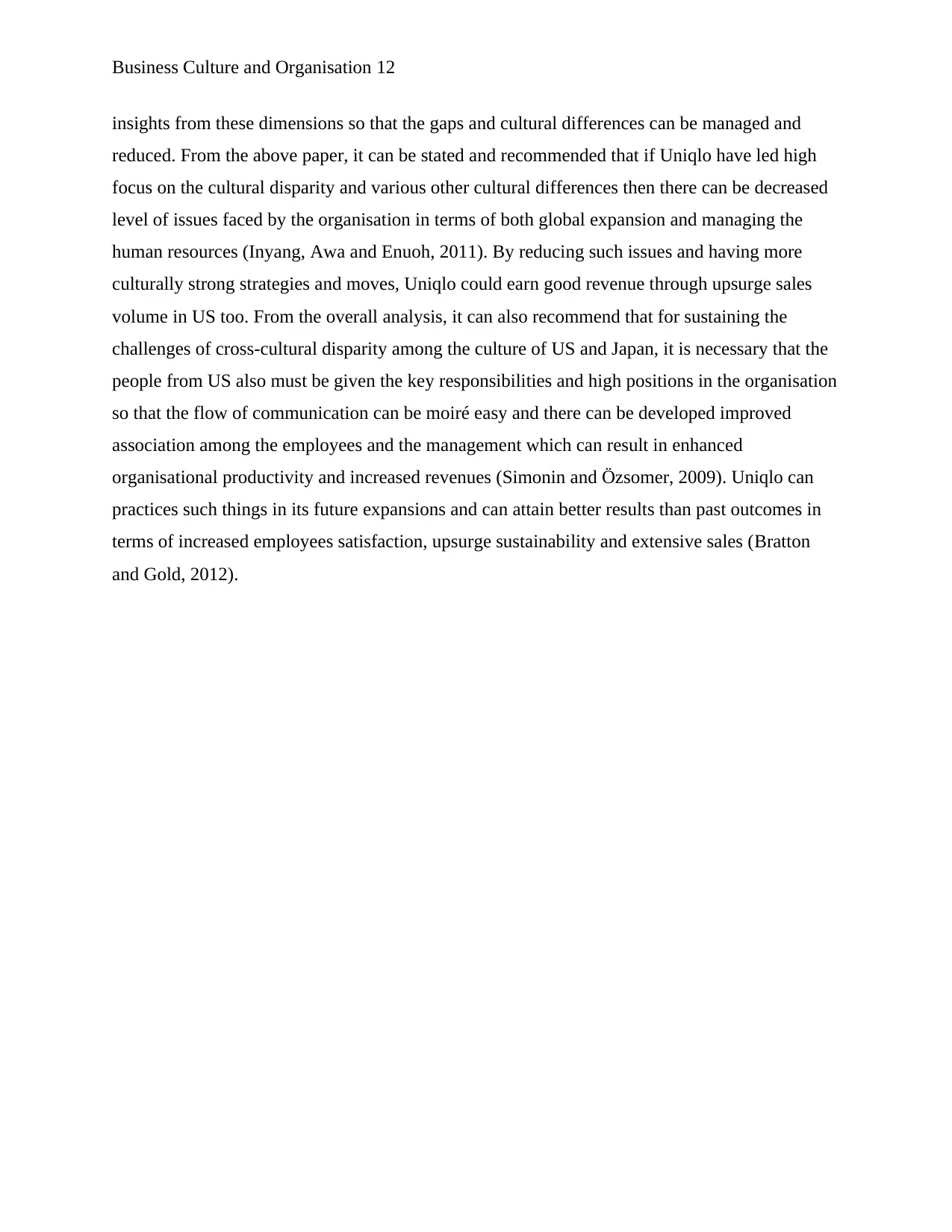
Business Culture and Organisation 12
insights from these dimensions so that the gaps and cultural differences can be managed and
reduced. From the above paper, it can be stated and recommended that if Uniqlo have led high
focus on the cultural disparity and various other cultural differences then there can be decreased
level of issues faced by the organisation in terms of both global expansion and managing the
human resources (Inyang, Awa and Enuoh, 2011). By reducing such issues and having more
culturally strong strategies and moves, Uniqlo could earn good revenue through upsurge sales
volume in US too. From the overall analysis, it can also recommend that for sustaining the
challenges of cross-cultural disparity among the culture of US and Japan, it is necessary that the
people from US also must be given the key responsibilities and high positions in the organisation
so that the flow of communication can be moiré easy and there can be developed improved
association among the employees and the management which can result in enhanced
organisational productivity and increased revenues (Simonin and Özsomer, 2009). Uniqlo can
practices such things in its future expansions and can attain better results than past outcomes in
terms of increased employees satisfaction, upsurge sustainability and extensive sales (Bratton
and Gold, 2012).
insights from these dimensions so that the gaps and cultural differences can be managed and
reduced. From the above paper, it can be stated and recommended that if Uniqlo have led high
focus on the cultural disparity and various other cultural differences then there can be decreased
level of issues faced by the organisation in terms of both global expansion and managing the
human resources (Inyang, Awa and Enuoh, 2011). By reducing such issues and having more
culturally strong strategies and moves, Uniqlo could earn good revenue through upsurge sales
volume in US too. From the overall analysis, it can also recommend that for sustaining the
challenges of cross-cultural disparity among the culture of US and Japan, it is necessary that the
people from US also must be given the key responsibilities and high positions in the organisation
so that the flow of communication can be moiré easy and there can be developed improved
association among the employees and the management which can result in enhanced
organisational productivity and increased revenues (Simonin and Özsomer, 2009). Uniqlo can
practices such things in its future expansions and can attain better results than past outcomes in
terms of increased employees satisfaction, upsurge sustainability and extensive sales (Bratton
and Gold, 2012).
⊘ This is a preview!⊘
Do you want full access?
Subscribe today to unlock all pages.

Trusted by 1+ million students worldwide
1 out of 15
Related Documents
Your All-in-One AI-Powered Toolkit for Academic Success.
+13062052269
info@desklib.com
Available 24*7 on WhatsApp / Email
![[object Object]](/_next/static/media/star-bottom.7253800d.svg)
Unlock your academic potential
Copyright © 2020–2025 A2Z Services. All Rights Reserved. Developed and managed by ZUCOL.





